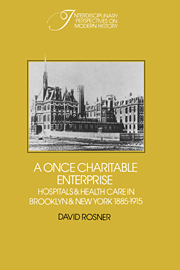Book contents
- Frontmatter
- Contents
- Preface
- Introduction
- 1 Health care and community change
- 2 Embattled benefactors: the crisis in hospital financing
- 3 Social class and hospital care
- 4 Conflict in the new hospital
- 5 Taking control: political reform and hospital governance
- 6 Consolidating control over the small dispensary: the doctors, the city, and the state
- 7 The battle for Morningside Heights: power and politics in the boardroom of New York Hospital
- 8 Looking backward
- Notes on sources
- Notes
- Select bibliography
- Index
6 - Consolidating control over the small dispensary: the doctors, the city, and the state
Published online by Cambridge University Press: 07 October 2009
- Frontmatter
- Contents
- Preface
- Introduction
- 1 Health care and community change
- 2 Embattled benefactors: the crisis in hospital financing
- 3 Social class and hospital care
- 4 Conflict in the new hospital
- 5 Taking control: political reform and hospital governance
- 6 Consolidating control over the small dispensary: the doctors, the city, and the state
- 7 The battle for Morningside Heights: power and politics in the boardroom of New York Hospital
- 8 Looking backward
- Notes on sources
- Notes
- Select bibliography
- Index
Summary
As we have seen, the Progressive era brought major changes in the city's political and social arrangements. The demographic shifts, economic upheavals, and political reforms that undermined the cohesiveness of neighborhoods and their small hospitals also hurt the free-standing dispensaries and small walk-in clinics located throughout working-class neighborhoods. Like the small hospitals, dispensaries were nearly totally dependent upon the influence of local merchants and leaders to obtain city money for their survival. When power shifted from locally elected politicians to city officials and bureaucrats, and when the state comptroller's officials changed reimbursement regulations to favor large institutions, the freestanding dispensaries felt the pinch most severely.
The Progressive era's shift in the locus of decision making was accompanied by similar changes throughout the society. In commercial activities, large corporations replaced local businessmen. Everywhere, people tended to place greater and greater faith in large, impersonal, bureaucratic institutions, and to question the ability of smaller organizations to provide services. The locus of health-care services also shifted away from small-scale undertakings toward larger corporate institutions. Doctors' offices and the small dispensary were replaced by large hospitals with a wider base of financial support, more influential trustees, and a more extensive and sophisticated physical plant. Individual doctors moved to these larger institutions; dispensaries came to be regulated by the state; local merchant-trustees lost power to organized charity. The decline of the dispensary as a viable form of basic health-care delivery in the twentieth century reflects the move to corporate forms of health-care organization.
- Type
- Chapter
- Information
- A Once Charitable EnterpriseHospitals and Health Care in Brooklyn and New York 1885–1915, pp. 146 - 163Publisher: Cambridge University PressPrint publication year: 1982



